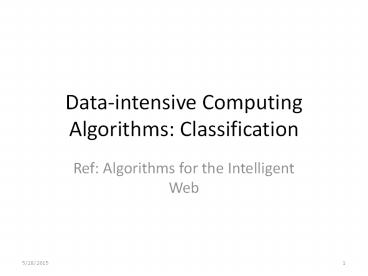Data-intensive Computing Algorithms: Classification - PowerPoint PPT Presentation
1 / 14
Title:
Data-intensive Computing Algorithms: Classification
Description:
Data-intensive Computing Algorithms: Classification Ref: Algorithms for the Intelligent Web * * Goals Study important classification algorithms with the idea of ... – PowerPoint PPT presentation
Number of Views:120
Avg rating:3.0/5.0
Title: Data-intensive Computing Algorithms: Classification
1
Data-intensive Computing Algorithms
Classification
- Ref Algorithms for the Intelligent Web
2
Goals
- Study important classification algorithms with
the idea of transforming them into parallel
algorithms exploiting MR, Pig and related
Hadoop-based suite. - Classification is placing things where they
belong - Why? To learn from classification
- To discover patterns
3
Classification
- Classification relies on a priori reference
structures that divide the space of all possible
data points into a set of classes that are not
overlapping. (what do you do the data points
overlap?) - What are the problems it (classification) can
solve? - What are some of the common classification
methods? - Which one is better for a given situation? (meta
classifier)
4
Classification examples in daily life
- Restaurant menu appetizers, salads, soups,
entrée, dessert, drinks, - Library of congress (LIC) system classifies books
according to a standard scheme - Injuries and diseases classification is
physicians and healthcare workers - Classification of all living things eg., Home
Sapiens (genus, species)
5
Categories of classification algorithms
- With respect to underlying technique two broad
categories - Statistical algorithms
- Regression for forecasting
- Bayes classifier depicts the dependency of the
various attributes of the classification problem.
- Structural algorithms
- Rule-based algorithms if-else, decision trees
- Distance-based algorithm similarity, nearest
neighbor - Neural networks
6
Classifiers
7
Advantages and Disadvantages
- Decision tree, simple and powerful, works well
for discrete (0,1- yes-no)rules - Neural net black box approach, hard to interpret
results - Distance-based ones work well for
low-dimensionality space - ..
8
Chapter 4
- Naïve Bayes classifier
- One of the most celebrated and well-known
classification algorithms of all time. - Probabilistic algorithm
- Typically applied and works well with the
assumption of independent attributes, but also
found to work well even with some dependencies.
9
Life Cycle of a classifier training, testing and
production
10
Training Stage
- Provide classifier with data points for which we
have already assigned an appropriate class. - Purpose of this stage is to determine the
parameters
11
Validation Stage
- Testing or validation stage we validate the
classifier to ensure credibility for the results. - Primary goal of this stage is to determine the
classification errors. - Quality of the results should be evaluated using
various metrics - Training and testing stages may be repeated
several times before a classifier transitions to
the production stage. - We could evaluate several types of classifiers
and pick one or combine all classifiers into a
metaclassifier scheme.
12
Production stage
- The classifier(s) is used here in a live
production system. - It is possible to enhance the production results
by allowing human-in-the-loop feedback. - The three steps are repeated as we get more data
from the production system.
13
Bayesian Inference
14
Naïve Bayes Example
- Reference http//en.wikipedia.org/wiki/Bayes_Theo
rem - Suppose there is a school with 60 boys and 40
girls as its students. The female students wear
trousers or skirts in equal numbers the boys all
wear trousers. An observer sees a (random)
student from a distance, and what the observer
can see is that this student is wearing trousers.
What is the probability this student is a girl?
The correct answer can be computed using Bayes'
theorem. - The event A is that the student observed is a
girl, and the event B is that the student
observed is wearing trousers. To compute P(AB),
we first need to know - P(A), or the probability that the student is a
girl regardless of any other information. Since
the observer sees a random student, meaning that
all students have the same probability of being
observed, and the fraction of girls among the
students is 40, this probability equals 0.4. - P(BA), or the probability of the student wearing
trousers given that the student is a girl. Since
they are as likely to wear skirts as trousers,
this is 0.5. - P(B), or the probability of a (randomly selected)
student wearing trousers regardless of any other
information. Since half of the girls and all of
the boys are wearing trousers, this is 0.50.4
1.00.6 0.8. - Given all this information, the probability of
the observer having spotted a girl given that the
observed student is wearing trousers can be
computed by substituting these values in the
formula - P(AB) P(BA)P(A)/P(B) 0.5 0.4 / 0.8 0.25































